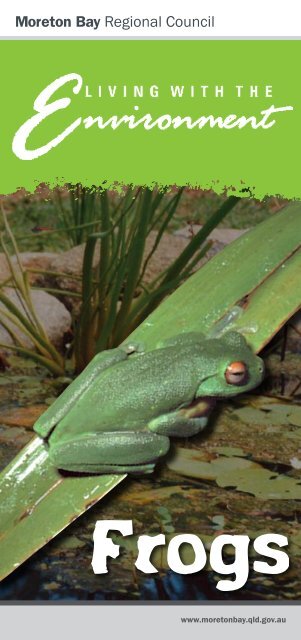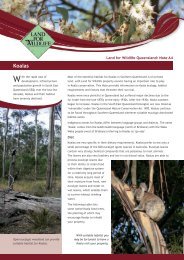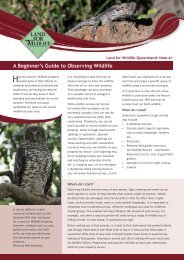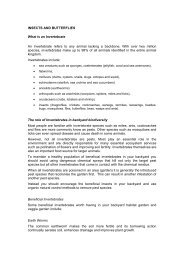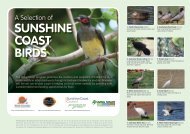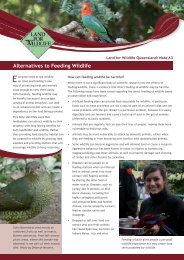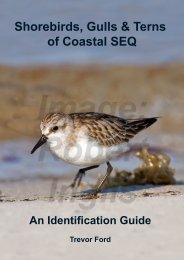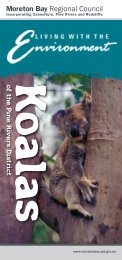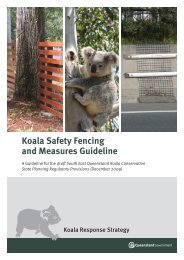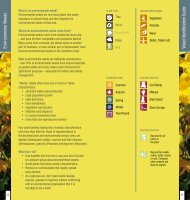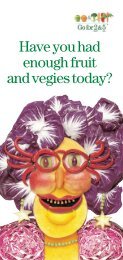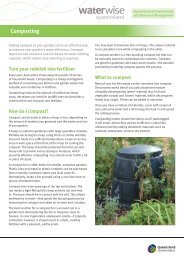Frogs Booklet - Moreton Bay Regional Council
Frogs Booklet - Moreton Bay Regional Council
Frogs Booklet - Moreton Bay Regional Council
Create successful ePaper yourself
Turn your PDF publications into a flip-book with our unique Google optimized e-Paper software.
www.moretonbay.qld.gov.au
<strong>Frogs</strong> include some of ourmost interesting and bestlovedcreatures. Althoughsome species are verycommon, some extremelyvocal, and some particularlycolourful and beautiful, mostare not well known.
<strong>Frogs</strong> are vertebrates (animals with backbones)and belong to the Class Amphibia.All Amphibians:• Have a three-chambered heart.• Use the skin as a respiratory (breathing) surfaceto augment the function of their lungs.• Spend part (or all) of their life asa larval stage living in freshwater.Amphibians include frogs, newts,salamanders, axolotls and caecilians.<strong>Frogs</strong> are the only amphibiansnative to Australia.Toads are frogs,but there areno true toadsnative to Australia.The Cane Toad is anintroduced pest.The frog family (Family Anura)is an ancient group. They may befound as fossils as oldas 250 million years.This predates the dinosaurs.The region which includes South-East Queensland andNorth-East New South Wales has a greater varietyof frog species (more than 50) than any otherAustralian region of similar size.The reasons for this are explained inChapter 22 of council’s dual-award winning book:Living with the Environment in the Pine Rivers Shire.
Some frogs have adaptedto producing young withoutusing water in streams,ponds or other water bodies.
A great many Australian frogs are adapted to breedingin ephemeral (short-lived) ponds, and swamps, lagoonsand billabongs. Some breed in permanent ponds. Afew have adapted to producing young without usingthe water in streams, ponds or other water bodieseg. tadpoles of Gastric Brooding <strong>Frogs</strong> develop in thestomach of the female.Typical Life Cycle of a FrogLarva (Tadpole)EggsAdult
Requirements of <strong>Frogs</strong>Generally, frogs require:1. Shelter- in daytime during breeding periodsThis may be in hollows, cracks and crevices in rocksand logs, under leaf litter, in sand or gravel, or on theunder-sides of shady leaves.2. Refuge- during non-breeding times and during droughtsSome frogs burrow into leaf litter, soil or sand; otherslive in cracks, crevices and hollows in trees, logsand rocks.3. FoodMany frogs eat insects, spiders and other smallinvertebrates. Large frogs may eat small lizards, miceor small birds. Some may eat other frogs. While theyare young, tadpoles usually eat algae and otheraquatic plant matter.4. Water for breedingMost frog species have particular water requirements.Some tadpoles need shallow water, others deep water.Some prefer still water and some running water. Eggsmay need to be attached to emergent or submergedplants. Eggs of some species float on the water in akind of foam or froth. Acidity and temperature ofwater are important factors for some species.There has to be sufficient water present long enoughfor tadpoles to complete their development.Most Australian frogsbreed in temporary(ephemeral) pondsIn mowed open areas,water evaporates beforefrogs have developed
Some frogs burrow into leaflitter, soil or sand. Others livein cracks, crevices and hollowsin trees, logs and rocks.
The way in which frogs lay their eggs varies with thedifferent species and with the different genera.Eggs may be laid singly or in small or larger groups.They may be attached to floating or submergedvegetation. Some frogs (for example the broodfrogs)lay their eggs in nests above the water before floodingoccurs. Others (eg. Limnodynastes species) lay theireggs in a floating foam mass.Foam Egg Mass (froth)of the Striped MarshfrogSome specialised frogs have remarkable adaptationsthat decrease their dependence on water. For example,tadpoles of the Australian Marsupial Frog complete theirtadpole stage in the hip pouches of the male.5. MatesOnly male frogs call – to attract females. Females selectthose males that make the ‘best’ calls. The females areattracted to calls of only their own species. This ensuresthat frog species do not interbreed. Knowledge of thecalls of frogs is an important tool for quick and accuratefrog identification.Great Barred-frogsmating (amplexing)Male GracefulTreefrog calling
<strong>Frogs</strong> in Ecosystems<strong>Frogs</strong> (except Cane Toads) are an essential part ofAustralia’s natural environment. They help to control thepopulations of animals that they feed upon. Australianadult frogs eat only food that moves.<strong>Frogs</strong>, in turn, become food for other predators.Animals that eat frogs include some snakes, goannasand some other lizards; freshwater turtles, egrets,bitterns, kookaburras, quolls, antechinuses and dingoes.Some Predators of <strong>Frogs</strong>Great EgretTorresian CrowPurple Swamp HenFreshwater Snake(Common Keelback)eating a Cane ToadThe harmless CommonKeelback snake is a majorpredator of Cane Toads
The Future for <strong>Frogs</strong>When land development occurs, frog habitat is usuallylost – soaks, depressions, swamps, ponds, gullies andother small watercourses are levelled, drained or filled.Native vegetation is cleared,bushland leaf litter is lost,fallen logs are disposed of,and old trees with crevicesand hollows are trimmed.This was once a streamwith frog habitatWhen people move into new residential and industrialestates, the use of exotic plants increases. Extensiveareas of lawn are established and the use of chemicals(fertilisers, insecticides, fungicides and herbicides, etc)increases. More dogs and cats arrive. Cane Toads arethe frogs that benefit most from these changes.We can help to ensure that during and afterdevelopment, remaining natural habitats andcorridors are not degraded:• When we live near frog habitat we should notcomplain about the calls of frogs during and afterheavy rain – it only happens a few times a year; andwhat a joyous sound!• The native reeds, rushes and grasses near streams, inlow hollows and other wet areas should not be mowedto control ‘vermin’. This displaces and kills bandicoots,fairy wrens, grass birds, rails, crakes, moorhens, lizards,snakes and other protected native animals and frogs.• Frog habitat may not be the major source ofmosquitoes. Often these mosquitoes are salt marshvarieties or ones that breed in plant pot saucers, leavesof bromeliaeds, old tyres or discarded containers. Leaflitter in roof gutters may cause water to collect andallow mosquitoes to breed.<strong>Frogs</strong> need wetland areaslike this, though somemosquitoes may alsobreed here.
Attracting <strong>Frogs</strong> to our GardensOnce suitable environments have been provided,frogs will arrive to take up residence in our gardens.We should not bring frog eggs, tadpoles or adultfrogs from elsewhere. This is against the law and it canspread frog diseases. <strong>Frogs</strong> do not normally travel largedistances. Artificial movement of frogs by humans candisrupt the dynamics of breeding populations.Striped Marshfrogs are usually the first frogs to breedin newly established ponds – they are the pioneerspecies able to tolerate conditions that are notsuitable for other more-demanding frogs.Other kinds of frogs will begin to use the pond,as the environment becomes suitedto them. We should not takefrogs from our own pondsto other places.Similarly, we shouldnot take freshwaterplants, soil, sand orpebbles from ourown frog pondsto other people’sfrog ponds, orfrom their ponds toours. This may alsospread diseasesof frogs.You may wish to join a local bushcare group tohelp remove weeds, restore local native plantcommunities to assist the survival of nativeanimals (including frogs), and learn more aboutnatural Australian ecosystems andour native wildlife.
We can do many things to make ourown yards ‘frog-friendly’:• Build a garden pond. This can be done cheaply andsafely (see council’s dual-award winning book,Living with the Environment in the Pine Rivers Shire,for instructions).Garden ponds can bemade safe for childrenGarden pond, withlocal native plants andmicro-habitats for frogs• Decrease the area under lawn. Extensive lawns areheaven for Cane Toads.Cane Toads love lawns, and findplaces nearby in which to hide• Construct rockeries using boulders and river rocks,and provide hilled areas of sand and gravel.Boulders local to the area and partly buried, lookmore natural than rocks from elsewhere.Rockeries can be planted with small native plantssuch as heathland plants.Planted rockeries with sandand gravel are great for frogs• Provide shelter and refuge fora variety of frog species – riverstones, gravel, sand, mulch andleaf litter, logs and hollows, and moist shady places withleafy local native plants.• Plant multi-layered habitats of ground covers,shrubs and small trees.• Use local native plants. There are suitable ones forevery situation. Call council for advice.
A Few Frog-Friendly Plantsfor Around PondsCommon Name Scientific Name CommentsRiver LilyBrisbane LilyMat RushesNative GingerNative Lasiandra /Blue TongueBird’s Nest FernCrinumpedunculatumProiphyscunninghamiiLomandra longifolia& L. hystrixAlpinia caeruleaMelastomamalabathricumAspleniumaustralasicumHardy, sun orshade; strap-likeleaves; to 1mHardy, part sun toshade; wide leaves;to 60cmHardy, sun toshade; long thinleaves; to 1mHardy, part sun toshade; wide leaves;to 1. 5mHardy, sun topart shade; pinkflowers; to 1. 5mHardy, part sun toshade; wide leaves;to 1.5m wide &60cm highA Few Frog-Friendly Plantsfor PondsCommon Name Scientific Name CommentsSwamp LilyWater SnowflakeWavy MarshwortMarsh Flower<strong>Frogs</strong>mouthOttelia ovalifoliaNymphoides indicaNymphoidescrenataVillarsia exaltataPhilydrumlanuginosumOval leaves;cream flowerswith dark basesRound leaves;white flowerswith yellowcentresRound leaves &yellow flowersEmergent; ovalerect leaves;yellow flowersEmergent;erect leaves;yellow flowers
• Destroy Cane Toads (humanely, by placing them inthe freezer overnight in a plastic bag). Remember, youngCane Toads can be confused with some small, toad-likenative frogs (see below).Underside of ayoung Cane ToadUnderside of a youngCopper-backed BroodfrogYoung Cane Toads (left) can be confused with nativefrogs such as the Copper-backed Broodfrog (right)• Destroy Cane Toad Tadpoles (by scooping them outwith a small net). Cane Toad tadpoles are small, dark andglossy, and gather in closely-packed groups inshallow water.• Destroy Cane Toad Egg Masses (by scooping themout of the water by using a net or forked stick).Cane Toad egg masses are long, slimy grey strings withmany black dots (eggs).• Do not use any chemicals in the garden.Up to eighty percent of fertiliser (and other chemicals)added to farms and gardens, ends up in streams.Pesticides kill birds, frogs, skinksand predatory insectsthat protect our plants. Ifa plant is not doing well,let it die or replace it. It isnatural for leaves of plantsto be chewed and eaten.Chewed leaves may meanwe have butterflies. All thesechemicals cause problems forfrogs; and we do not need touse them.
Our Local <strong>Frogs</strong>Green-thighed Frog (Litoria brevipalmata)Rich chocolate colour; dark band from snout becomingwider towards flank; green to blue in groin and behindthighs. Patchy distribution – Gympie to Sydney.First confirmed sighting in the region – 1999.Call: A repeated series of ‘quacks’ that begin slowly andincrease in tempo.Length: To 40mm.Tadpoles: Entirely brown,with high tail fins.Green-thighed Froga rare frog recently discoveredin the regionGreen Treefrog (Litoria caerulea)Light to dark green; white underparts; dark eyes.Call: A deep repeated ‘croak’ – the only localfrog that croaks.Length: To 100mm.Tadpoles: Dark green/grey-greenand become very large.Green Treefrogour best-known frogSouthern Orange-eyed Treefrog(Litoria chloris)Green above, white to yellow under; reddish-orangeeyes. Green lips distinguish it from the Graceful Treefrog.Call: A series of rising, wailing‘arks’, followed by trills.Length: To 65mm.Tadpoles: Dark and large.Southern Orange-eyedTreefrog
Cooloola Sedgefrog (Litoria cooloolensis)Not yet discovered in our region, but has been foundon coastal sand islands where perched lakes occur eg,North Stradbroke Island. A small, slender, green frogwith spotted body; cream underparts; back of thighspurplish brown; associated with wallum habitat, lowlandrainforest and sandy lakes; calls from vegetation in ornear water.Call: A series of highly pitched“reek…pip pips”.Length: To 25mm.Tadpoles: Dark tailed withpale body.Cooloola Sedgefroga rare speciesBleating Treefrog (Litoria dentata)Overall brownish with a three-lobed darker patchdown middle of back.Call: Repeated long high-pitchedquivering ‘eeeeeeat’ –eardrum-shattering up close.Length: To 45mm.Tadpoles: Entirely brown.Bleating TreefrogEastern/Dwarf Sedgefrog (Litoria fallax)Small size; overall green to pale-brown; black stripe fromthe nostril through eye, and white stripe from jaw toshoulder.Call: ‘Tweek-up’ followed byshort ‘kips’.Length: To 25mm.Tadpoles: Pale or very patternedbody, dark tail.Eastern/Dwarf Sedgefrog
Wallum Rocketfrog (Litoria freycineti)Declining locally. A pale grey-brown frog with largeraised bumps over head, back and legs; pointy snout;dark, broken stripe from nose tip, through eye area toarm; darker brown irregular blotches over body; an‘acid frog’ - occurs in lowland sandy swamps in wallumhabitat, eg, Bribie Island.Call: A fast and accelerating quacking.Length: To 50mm.Tadpoles: Medium sized greybrownwith a copper sheen.Wallum RocketfrogGraceful Treefrog (Litoria gracilenta)Bright-green upper surface; yellow underparts; orangeeyes and yellow lips.Call: Drawn-out, rising snore-like‘aaaaaaaah’.Length: To 45mm.Tadpoles: Dark, fairly uniform andtinged yellowish.Graceful TreefrogBroad-palmed Rocketfrog (Litoria latopalmata)Streamlined; pointed nose; long back legs. Upper partsgrey to dark brown (without the lengthwise skin-folds orstripes of the Striped Rocketfrog); back of thighs yellowwith darker markings.Call: Series of ‘quacks’ becomingfaster and unequally spaced.Length: Female to 45mm,males to 35mm.Tadpoles: Dark brown; high tailfins; to medium size.Broad-palmed Rocketfrog
Stony-creek Frog (Litoria lesueuri)Light grey to brown (male lemon-yellow whenbreeding); under surface white; thin dark line fromnostril to arm; groin yellow with black patches.Call: Soft whirring heard onlyup close.Length: Female to 70mm;males to 45mm.Tadpoles: Dark; low tail fins.Stony-creek Frog - maleStriped Rocketfrog (Litoria nasuta)Very streamlined; pointed nose; long back legs. Lightgrey to dark brown; longitudinal stripes and skin-foldsdown middle of back; dark stripe from nostril to behindear disk with pale narrow rim; back of thigh yellow withblack stripes.Call: High pitched intermittent ‘chirps’ becoming morefrequent and followed by evenly-spaced ‘quacks’, andthen slow ‘chirps’.Length: Females to 50mm,males to 40mm.Tadpoles: Dark brown; high tailfins; to medium size.Striped Rocketfrog‘one giant leap’Wallum Sedgefrog (Litoria olongburensis)Declining locally. Small, bright green to light brown frog;pointy snout; dark stripe from nostril to flank, and belowthis, a cream stripe from eye to flank; brown speckledthroat; cream underparts; an ‘acid frog’ - occurs inlowland sandy swamps inwallum habitat, eg, Bribie Island.Call: A “creek…crik”.Length: To 25mm.Tadpoles: Small, dark purple-brownwith mottling.Wallum Sedgefrog
Cascade Treefrog (Litoria pearsoniana)Green to brownish; gold stripe from nose through eye;groin and back of thighs dull red.Call: Rising quivering drawn-out ‘eeeeek’,then ‘chik, chik’.Length: To 40mm.Tadpoles: Dark; high tail fins;small.Cascade TreefrogEmerald-spotted Treefrog (Litoria peronii)Light grey to brown; rough skin; dark mottling andiridescent green spots on back; under surface yellowishwith dark specks on throat; groin yellow with blackmottling; eye pupil with cross.Call: Loud stuttering or rattling wail.Length: To 65mm.Tadpoles: Bright green; archedtail fins; large jaws.Emerald-spotted TreefrogNaked Treefrog (Litoria rubella)Colour varies – white, grey, pink, or fleshy brown.Call: Loud ‘creeeeek’ rising slightly in pitch,repeated regularly.Length: To 40mm.Tadpoles: Entirely brown.Naked Treefrog
Laughing Treefrog (Litoria tyleri)Off-white to brown; skin rough; few iridescent greenspots on back; yellowish white underneath; groin andback of thighs yellow with dark mottling.Call: Several ‘acks’ falling in pitch.Length: To 60mm.Tadpoles: Bright green; archedtail fins; large jaws. Often restsat 45º in the water.Laughing TreefrogGreen-striped Frog (Cyclorana alboguttata)Declining locally. Not yet discovered in our region, butoccurs close by and may occur here. Large greenishbrownfrog with a green stripe down middle of back.Back lumpy and with length-wise folds. Back of thighsdark and spotted yellow and white. Curved dark stripefrom mouth, across eye and ear-disc, and past forearm –immediately below this stripe isgreen. Underneath body white.Eats other frogs.Call: ‘quack’ repeated.Length: To 80mm.Tadpoles: Entirely brown.Photo: Donna FlynnGreen-striped FrogTusked Frog (Adelotus brevis)Greenish brown to dark grey above, often with irregularpatterns; cross bars on limbs; skin rough with low lumpsand ridges. Underside smooth and mottled black andwhite; throat grey with white specks. Red in groin; redspots at back of hind legs. Head of male large andwith a pair of tusks at front of lower jaw.Call: A short, two-syllabled ‘tl-uck’,repeated at about 5 secondintervals.Length: Female to 50mm;Male to 40mm.Tadpoles: Dark grey; become large.Tusked Frog
Marsupial / Pouched Frog (Assa darlingtoni)Grey to pinkish brown. An inverted V-marking betweenthe eyes and one on the middle of the back; dark widestripe on sides; white beneath; throat with brownmottling. Male with a pouch with slit openings on eachhip where tadpoles live.Call: Series of high-pitched ‘chits’.Length: To 25mm.Tadpoles: White; without tail fins.After hatching, are carried inhip-pouches of male.Marsupial/Pouched FrogBeeping Froglet (Crinia parinsignifera)Variable colouring but usually brown to grey; patternedon back or plain; back smooth or bumpy. Underneathwhitish with fine dark speckling. Base of arm with a palepatch. Toes and fingers long.Call: Repeated short ‘eek’; occasionallyrepeated quickly like a laugh.Length: To 25mm.Tadpoles: Fat body; short tailwith low tail fins.Beeping FrogletClicking Froglet (Crinia signifera)Colour very variable, but usually brown to grey;patterned on back or plain, smooth or warty. Pale patchnear where arm is attached. Underneath with darkmarbling on white.Call: Repeated two syllabled crik- it’.Length: To 30mm.Tadpoles: Fat body; short tail withlow tail fins.Clicking Frogleta winter caller
Wallum Froglet (Crinia tinnula)Very variable, but usually brown to grey. Underneathwhitish with fine dark speckling, and usually with a finewhite line from under the chin to the belly, and a lineacross the throat.Call: Repeated ‘tink’; sometimesrepeated quickly like a laugh.Length: To 20mm.Tadpoles: Fat body; short tail withlow tail fins.Wallum Frogletour smallest frogOrnate Burrowing-frog (Limnodynastes ornatus)Rounded frog with high protruding eyes. Very variablein colour with mottles and meandering dark stripes andblotches on a grey or yellowish light brown background;underside white; narrow or broad dark bars on legs.Call: A throaty gulp, like ‘uhnck’.Length: To 45mm.Tadpoles: Dark; tail mottled; small.Ornate Burrowing-frogStriped Marshfrog (Limnodynastes peronii)Light brown to grey-brown with length-wise continuousor broken dark bands. One dark band with a yellowishstripe down its centre runs down the centre of the back;and there are two narrow bands either side of this.A dark band runs from the snout, through each eye andto above the shoulder. Undersidewhite. Males yellow under throat.Call: ‘tok’ repeated every 4 or5 seconds.Length: To 45mm.Tadpoles: Entirely brown.Striped Marshfrogcan tolerate some pollution
Salmon-striped Frog (Limnodynastes salmini)Declining locally. Not yet discovered in our region, butmay occur here. A brownish, greyish large frog withthree length-wise red, pink or salmon stripes and darkblotches on back. Curved dark band through eye to eardisc.Underside white with dark mottling on inner thighsand throat.Call: ‘wok’, repeated everycouple of seconds.Length: To 70mm.Tadpoles: Pale and mottled.Salmon-striped FrogPhoto: QMSpotted Marshfrog (Limnodynastes tasmaniensis)Light grey, with blotches and spots of brown; curveddark band from mouth through eye and ear-disk toabove arm; white underneath. Males with yellowishthroat.Call: A nasal stutter of severalsyllables like ‘ah-ah-ah’.Length: To 45mm.Tadpoles: Entirely brown.Spotted Marshfrogindicates good water qualityScarlet-sided Pobblebonk(Limnodynastes terraereginae)Dark grey sides; upper thigh and upper arm yellowishorange; groin and back of thigh scarlet.Likes sandy gravelly soils; leaf-litter near ponds.Call: ‘bonk’, repeated every 4 – 5 seconds.Length: To 75mm.Tadpoles: Dark with mottled tail.Scarlet-sided Pobblebonk
Great Barred-frog (Mixophyes fasciolatus)Large, brown to fawn frog with a wide head and largedark eyes. Narrow dark stripe from nostril, through eyeto ear-disc. Thin dark lines across legs.Call: Occasional low ‘wark’.Length: To 80mm.Tadpoles: Brown and mottled;low tail fins; to very large.Great Barred-frogGiant Barred-frog (Mixophyes iteratus)A large frog with big golden eyes; olive brown bodywith irregular blotches; dark stripes (bars) on legs andarms; small yellow spots on inner thighs; calls from leaflitter along the banks of creeks and streams. Found inrainforest along Burpengary Creek.Call: A deep guttural grunt.Length: To 115mm.Tadpoles: Large golden brownwith prominent eyes;found in flowing water.Giant Barred-frogan endangered speciesGreat Brown Broodfrog (Pseudophryne major)Reddish back, brighter towards the sides.Sides dark to black. Black and white marblingunderneath, pinkish upper arm.Call: A short, grunt-like ‘eak’lasting about a second.Length: To 35mm.Tadpoles: Dark brown;tail mottled.Great Brown Broodfrog
Copper-backed Broodfrog (Pseudophryne raveni)Copper pink-red on back; dark red sides with black band.Upper arm grey to copper-pink; marbled blackand white underneath.Call: A low creak like ‘eeaaark’lasting about a second.Length: To 35mm.Tadpoles: Dark brown; tail mottled.Copper-backed BroodfrogSouthern Dayfrog (Taudactylus diurnus)May be extinct. Common in D’Aguilar Range until late1970s. Brown to grey small frog with dark bar betweeneyes, and dark H-shaped mark between shoulders;underneath cream to bluish, sometimes with grey spots.Call: Very soft clucking sounds.Length: To 30mm.Tadpoles: Snout and end oftail rounded.Photo: BFPSouthern DayfrogSandy Gungan (Uperoleia fusca)Small frog with dark grey to brown lumpy back,sometimes with dark blotches. Large glands onshoulders. Dark undersurface. Groin and back of thighyellow to orange – distinguishes them (and othergunguns) from small Cane Toads; upper surface of armfawn to yellow.Call: A trilled ‘eeeeek’.Length: To 30mm.Tadpoles: Dark brown; high tailfins; small.Sandy Gungan
Eastern Gungan (Uperoleia laevigata)Small bumpy brown to dark grey frog. Large glandabove shoulder has a curved dark stripe above it;purplish-brown underneath; yellow on upper arm;orange behind thigh and in groin.Call: A rasped ‘e-e-e-k’ with the hint of an echo.Length: To 30mm.Tadpoles: Dark brown;high tail fins; small.Eastern GunganCane Toad (Bufo marinus)An exotic pest. The largest frog found in our region.Cane Toads, even small ones, can be distinguished fromall other frogs by the bony ridge that overhangs eacheye and extends to above the nostrils. Behind eacheardrum is a very large poison gland.The back is lumpy, and brown to orange-brown.
Chubby Gungan (Uperoleia rugosa)Overall grey-brown with darker small patches; greyunderneath; yellow to red behind thigh and in groin;grey underneath. Large gland behind eye, and a smallone behind this.Call: Short grunt-like ‘ek’.Length: To 30mm.Tadpoles: Dark brown;high tail fins; small.Chubby GunganUnderneath is white to off-white, sometimes with darkmarbling (often in very young ones).Call: A continuing, motor-like, ‘tudle-udle-udle-’.Length: To 200mm.Tadpoles: Small and black, always in groups,in shallow water.Cane Toadanother unfortunateintroduction of an exotic species
<strong>Frogs</strong> of OUR REGION(+) = species may have occurred here in the past and may yetbe discovered in this region(*) = introduced pest speciesScientific NameLitoria brevipalmataLitoria caeruleaLitoria chlorisCommon NameGreen-thighed FrogGreen TreefrogSouthern Orange-eyed Treefrog+ Litoria cooloolensis Cooloola SedgefrogLitoria dentataBleating TreefrogLitoria fallaxLitoria freycinetiLitoria gracilentaLitoria latopalmataLitoria lesueuriLitoria nasutaLitoria olongburensisLitoria pearsonianaLitoria peroniiLitoria rubellaLitoria tyleri(+)Cyclorana alboguttataAdelotus brevisAssa darlingtoniCrinia parinsigniferaCrinia signiferaCrinia tinnulaLimnodynastes ornatusLimnodynastes peronii(+)Limnodynastes salminiLimnodynastes tasmaniensisLimnodynastes terraereginaeMixophyes fasciolatusMixophyes iteratusPseudophryne majorPseudophyrne raveniTaudactylus diurnusUperoleia fuscaUperoleia laevigataUperoleia rugosa(*)Bufo marinusEastern/Dwarf SedgefrogWallum RocketfrogGraceful TreefrogBroad-palmed RocketfrogStony-creek FrogStriped RocketfrogWallum SedgefrogCascade TreefrogEmerald-spotted TreefrogNaked TreefrogLaughing TreefrogGreen-striped FrogTusked TreefrogMarsupial (Pouched) FrogBeeping FrogletClicking FrogletWallum FrogletOrnate Burrowing-frogStriped MarshfrogSalmon-striped FrogSpotted MarshfrogScarlet-sided PobblebonkGreat Barred-frogGiant Barred-frogGreat Brown BroodfrogCopper-backed BroodfrogSouthern DayfrogSandy GunganEastern GunganChubby GunganCane Toad
CommentsRecently discovered in our region; vulnerableUses tree hollows and down pipesMountain rainforest canopy; comes down to breed inponds and pools during good rainWallum habitat; coastal sand islands where perched lakes occurCracks and crevices in rocks and treesUsually the most common frog in home gardens.Rests on leafy shrubs and reedsCoastal sandy swamps and wallum habitatTree hollows and cracks, and leafy plantsGrassy areas near temporary pondsStony, shady creek bedsGrassy and reedy temporary pondsCoastal sandy swamps and wallum habitatMountain streams in rainforest. Crevices in rocks and treesCracks and crevices high in treesCracks and crevices in rocks & treesCracks and crevices in logs & treesAlluvial flats and lowlands.May occur in our region; burrows; cannibalUnder rocks and logs and in crevicesRecently found in our region – Mt Glorious; rare; rainforestLeaf and grass litter near temporary pondsLeaf and grass litter; winter callerWallum swamp edges; rare in our regionGrass litter and sand near ephemeral pondsNewly made ponds; grassy wet areasMay occur in our region; grassy swampy flatsGrassy, unpolluted, ephemeral pondsSandy and gravelly soil; leaf litter near pondsWetter scrubby creeks and ponds; rainforestWet sclerophyll and rainforest areas;leaf litter near running water; endangeredGrassy and open-forested wet areasGrassy and forested drainage lines and gulliesRocky mountain streams; probably extinctGrassy open forest; temporary pondsGrassy open forest; temporary pondsGrassy open forest; temporary pondsImported pest. Loves lawns, roads & lights
USEFUL CONTACTSQueensland Frog SocietyThis organisation provides biology and identificationassistance for newcomers to the world of frogs, as wellas education through field trips, lectures, slide nightsand regular newsletters.www.qldfrogs.asn.auRANA - Restoring Australian Native AmphibiaA not for profit group which aims to provide peoplewith an opportunity to learn more about our nativefrogs and frog habitat. The group can be contacted viawww.ranafrog.org.auFurther frog information (including call soundsand habitat information) may be found on the<strong>Frogs</strong> Australia website at www.frogsaustralia.net.auThanks to Steve Wilson for the majority offrog photos used in this brochure.
This brochure is printed on Dalton ENVI paper. ENVI is an Australian made,recycled range of carbon neutral uncoated papers.An EnvironmentallyResponsible ProductSunshineCoastBribieIslandCabooltureSomersetRegionMORETON BAYREGIONRedcliffe<strong>Moreton</strong> <strong>Bay</strong>StrathpinePort ofBrisbaneBrisbaneMORETON BAYREGIONNorthStradbrokeIslandThis brochure is one in the series,Living with the Environment,produced by <strong>Moreton</strong> <strong>Bay</strong> <strong>Regional</strong> <strong>Council</strong>.These brochures feature the manymarvellous plants, animals and other naturalfeatures of the region. They are designed tohelp residents know, understand, love andconserve our unique natural heritage.© <strong>Moreton</strong> <strong>Bay</strong> <strong>Regional</strong> <strong>Council</strong> 2008


